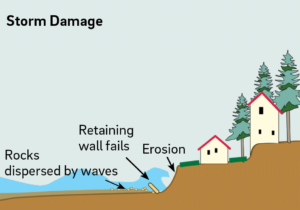Island shorelines are valuable for ecological and cultural reasons.
Much of the Salish Sea’s marine life, including salmon, whales, and birds, relies on nearshore habitat for spawning, early life, or food.
From clam gardens to fish weirs to middens, the shorelines of the Trust Area reflect First Nations people in this region since time immemorial.
Islands Trust is here to work with you to ensure the preservation and protection of shorelines. Find out more about what we’re doing, local priorities, and get access to resources below.

1. Climate change in our region is resulting in more frequent and more severe winter storms, plus slowly rising sea levels. This can lead to increased erosion of beaches and shorelines. Scientists predict the trend will continue in the future.
2. Some homeowners have built hard structures to hold back the sea from homes and properties when trying to protect shorelines in low-lying areas. Scientific studies show these measures increase erosion and negatively impact shore, beach and sea life.
3. Many landowners successfully protect their shoreline properties using natural materials, slopes, and plantings. For more see the publication Your Marine Waterfront: A Guide to Protecting your Property while Promoting Healthy Shorelines.
What We Are Doing
- Offering stewardship education programs
- Helping you protect shorelines with the Natural Area Protection Tax Exemption Program (NAPTEP)
- Collaborating with First Nations and conservation groups to monitor nature reserves and conservation covenants
- Conducting mapping and inventories of shoreline ecosystems and fragile cultural heritage sites
- Enforcing shoreline bylaws and development permit area regulations where they are in place
- Ensuring applications conform to the legal requirements necessary to preserve and protect shoreline archaeological sites
Local Priorities
- All local trust committees and Bowen Island Municipality have official community plan policies addressing shoreline protection and may also have shoreline protection projects underway. Learn more on their web pages
- Some islands have shoreline development permit areas and shoreline zoning regulations. You’ll find mapping details and restrictions on their webpages as well
Resources
Find useful resources in the Islands Trust Document Library and through Islands Trust Mapping. Other useful links include:
- Community and Shared Docks Case Studies from the B.C. Coast, Islands Trust, 2013
- Your Marine Waterfront: A guide to protecting your property while promoting healthy shorelines, Canadian Edition, Washington State, 2016
- Shorelines Matter
- Sharing our Shorelines Booklet, North Pender Local Trust Committee
- Stewardship Centre of BC Green Shores for Homes website
- Develop with Care, Forage Fish Fact Sheet, Province of BC, 2014
- Forage Fish-the Health of the Oceans brochure, Lasqueti Island Forage Fish Team, undated
- Shoreline Protection Model Bylaw Report, March 2021
Shoreline Maps
Distribution of shoreline type, energy and sediment movement, shoreline values and vulnerabilities:





